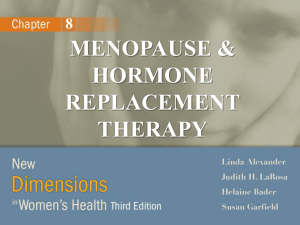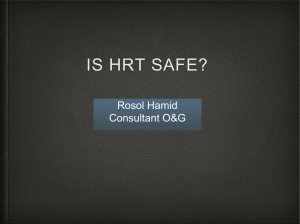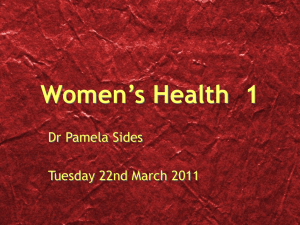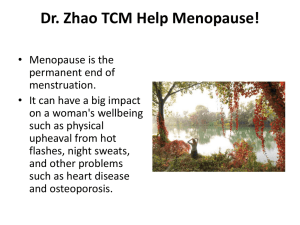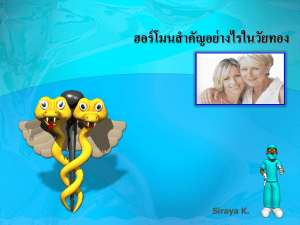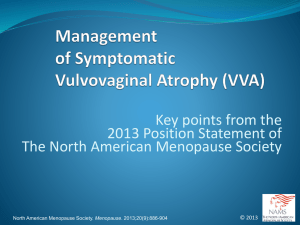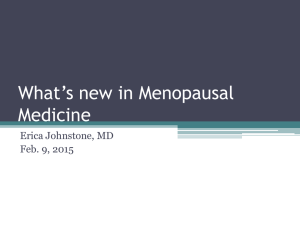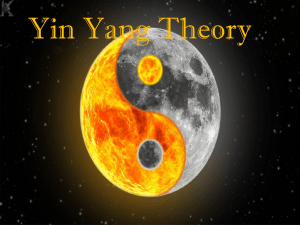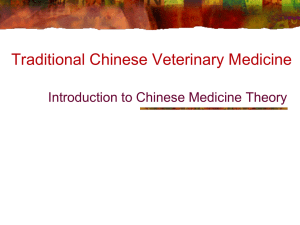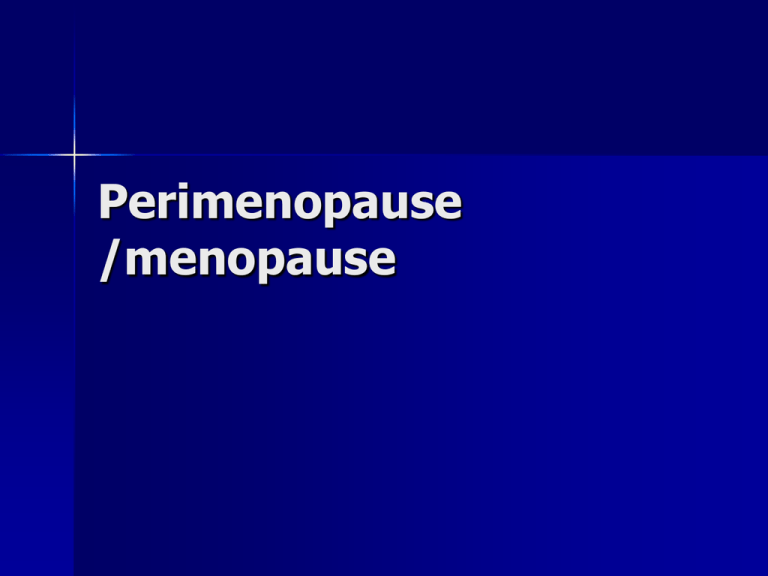
Perimenopause
/menopause
What is •••?
Hot flushes
Night sweats
Definitions
Menopause:
last menstrual period
♠ One complete year without a menstrual
cycle
♠
Perimenopause:
♠
transition into menopause. It can last for
2 to 8 years prior to menopause and
includes the first year after menopause
Three-step
Pre-menopause
Peri-menopause
Post-menopause
perimenopausal
syndrome
Definition:
In about 2/3 of the women in
perimenopausal period ,there appear a
series of symptoms due to deficiency of
sexual hormone.
♠ usually occurring in women ageing from
45 to 55.
♠
Menopause affects the women who suffer
from it as well as their loved ones!
Signs and Symptoms
Vasomotor symptoms:hot flashes, night
sweats
Vaginal dryness:painful intercourse,Vulvae
pruritus
Insomnia
Weight gain
Sexual changes
Irregular menses
Moon changes: Irritability,depression
Menopause: Etiology
Natural
Surgical
Premature
Post-chemotherapy/radiation
♠
cancer
♠cyst
,EMs
♠cancer
♠<40ys
Health Issues:
♠
♠
♠
♠
♠
♠
♠
Osteoporosis
Cardiovascular risk
Breast Disease
Diet modification
Exercise
Calcium intake, Vitamin D
Family history
Commonly–Asked
Questions
Is hormone replacement therapy (HRT)
safe?
What can I do about my lack of sex
drive?
What is HRT?
Combination of estrogen, progesterone and sometimes
testosterone
Estrogen is given for relief of hot flashes, night sweats and
vaginal dryness
Other advantages of estrogen:
♠ Improvement of sexual functioning
♠ Improvement with sleep
♠ Improvement with cognition
♠ Improvement of mood
♠ Prevents osteoporosis
♠ Decreases risk of fractures
♠ Decreases risk of colon and rectal cancer
♠ ? Improves skin
What is HRT?
Progesterone is given with estrogen to
prevent cancer and hyperplasia (precancer) of the lining in the uterus
(endometrium)
Estrogen alone is generally given to
those women who don’t have a uterus
Testosterone is given to improve
sexual dysfunction
Is HRT Safe?
Disadvantages of estrogen - based on the
WHI study (Women’s Health Initiative)
Coronary heart disease
♠ Stroke
♠ Venous Thromboembolism - clotting that occurs
in the deep veins (usually the legs, pelvis or
lungs)
♠ Breast cancer
♠ Endometrial cancer and hyperplasia (known)
♠
WHI Study
Mission: does Prempro (combo of
premarin and provera) or premarin
alone reduce cardiovascular risk
♠
(premarin is a conjugated estrogen and
provera is medroxyprogesterone acetate)
WHI Study
Results:
♠
♠
Prempro trial was halted prematurely after only
5.2 years due to the increased risk of CHD,
stroke, VTE, and breast cancer
Premarin-alone trial was halted prematurely due
to the increased risk of stroke
Due to these findings the number of HRT
prescriptions dropped by 50% from 1995 to
2003
WHI Study
The Headlines
41% increase in strokes
♠ 29% increase in heart
attacks
♠ Greater than 100%
increase in VTE
♠ 22% increase in total CVD
♠ 26% increase in breast
cancer
♠
37% decrease in
colorectal cancer
♠ 33% decrease in hip
fracture
♠ 24% decrease in total
fractures
♠
Not in the media about WHI
Average age was 63
Only 16% were within 5 years of their last
menses
♠ Most were an average of 12 years after their last
menses
♠ Most already had silent CVD
♠ 50% current or former smokers
♠ Average Body Mass Index 28.5, many obese
♠ Average participant was older, overweight
smoker
♠
♠
Is HRT Safe?
Take Home Message
HRT is safer for younger menopausal women
HRT is intended for relief of vasomotor symptoms
only (hot flashes, night sweats, vaginal dryness)
♠
♠
Flushing is worse between the transition from premenopause to perimenopause
Vaginal dryness, sweating, insomnia is most prominent
during the transition from perimenopause to postmenopause
WHI study tested only premarin and provera
♠
Many other forms of estrogen and progesterone
What can I do about
my lack of sex drive?
Definition:
♠
♠
decreased interest in sexual activity or lack of
sexual satisfaction.
40% of women between ages 18 to 59 report
some sort of sexual dysfunction.
Sexual functioning is a very important part
of a woman’s relationship with her partner.
Sexual dysfunction is very common during
the perimenopausal and post-menopausal
years.
Sexual Dysfunction
Causes:
♠
♠
♠
♠
♠
♠
Chronic disease
Medications
Psychological causes
Socio-cultural causes
Loss of estrogen
Loss of testosterone
Sexual Dysfunction
Medical problems as a cause for
decreased sexual activity
Endocrine disorders – diabetes, kidney disease
♠ Vascular diseases
♠ Atherosclerosis
♠ Neurologic disorders or injuries
♠ Alcohol or substance abuse
♠ Removal of the ovaries
♠
Snapshot
The number of women aged 50 and above is increasing as life
expectancy rises
Women can now expect to live greater portions of their lives
postmenopausal
Proactively managing menopause is an opportunity for women
to prevent disease and improve their long-term health and
quality of life
Menopause is a perfect time to evaluate your life and make
changes to ensure that you stay fit and healthy now and in
the future
Menopause
Derived from the Greek words for
“month” (men) and “cessation”
(pausis)
A natural event in a woman's life - this
is a time of change
What is menopause?
‘Menopause’ refers to the stage in a woman’s life
when her periods cease
Menopause occurs when the ovaries stop producing
the hormones oestrogen and progesterone
Usually occurs between ages of 45 and 55 years
Symptoms such as hot flushes, mood swings,
tiredness, loss of libido and irregular bleeding are
common
There are three stages of menopause
that take place over about a decade
♠
Peri-menopause
♠
Menopause
♠
Post-menopause
Peri-menopause
♠
The years prior to menopause (when
symptoms commence) and also the first
year after menopause
Menopause
Permanent cessation of menstruation which occurs when the
ovaries stop producing the hormones oestrogen and
progesterone
Natural menopause is recognised to have occurred once a
period of 12-months has lapsed after the last menstrual
period, and for which there is no other obvious cause
No specific indication marks the beginning of menopause
other than the onset of symptoms
Post-menopause
When one year has lapsed since the last
menstrual period
Some women may still continue to
experience menopausal symptoms for
several years following their last period
Hot flushes!!
The hallmark and the most commonly associated symptom
with menopause. This is just one of several symptoms that
may occur letting you know that menopause is on its way
Though not welcomed, these symptoms tend to be
experienced by the majority of women and are due to the
declining level of oestrogen in the body which up until now
has maintained the ‘hormonal balance’ all these years
The body is now moving into a state of readjustment and
learning to live without oestrogen
Hot flushes and night sweats
♠
Very common
♠
A sensation of heat spreads over your
body, in particular your head, face and
chest and is often accompanied by
flushing and sweating, followed by a chill
Menopause Western
Overview
Differentiation: menopause: natural
(49 – 50 y/o), artificial (surgery,
radiation), premature (< 40 y/o,
smoking, radiation, chemo)
Diagnosis: cessation of menses 1
yr, decreased response to LH, FSH,
shorter follicular phases, fewer
ovulations, less estrogen &
progesterone, rise of LH/FSH
Symptoms: none; hot flashes,
night sweats, fatigue, irritability,
insomnia, nervousness, dizziness,
paresthesias, palpitations,
tachycardia, ‘cotton head’, cystitis,
incontinence, vaginitis, arthralgia,
myalgia, digestive complaints,
increased risk for osteoporosis
Menopause Western
Overview
Treatment: counseling, antidepressants, tranquilizers, ERT:
estrone (Ogen); 17-beta estradiol (oral:
Estrace; transdermals: Estraderm,
Climara; vaginal: Estring) estriol: has
to be compounded; conjugated
estrogen (Premarin, similar to 17-beta
estradiol, may increase blood pressure)
Menopause Western
Overview
Progesterone: acts on osteoblasts:
medroxyprogesterone (Provera),
progesterone USP (Prometrium, Crinone);
testosterone
Natural Treatment: natural OTC estrogen &
progesterone creams, bi-est
(estradiol/estriol mix), tri-est (80 % estriol,
10 % estrone, 10 % estradiol), DHEA
Menopause Western
Overview
Lignans: cereals, fruits, vegetables,
flax seeds
Calcium: yoghurt, OJ, sardines, green
leafy vegies
Vitamin E: hot flashes, vaginal dryness
also topically
Menopause Oriental Views
Life begins from the dance of the opposing forces
of Yin & Yang, heaven & earth, day-time & nighttime, heating & cooling, moistening & drying,
contracting & relaxing.
Yang
Yin
Menopause Western
Overview
Lignans: cereals, fruits, vegetables,
flax seeds
Calcium: yoghurt, OJ, sardines, green
leafy vegies
Vitamin E: hot flashes, vaginal dryness
also topically
Menopause Oriental Views
Life begins from the dance of the opposing forces
of Yin & Yang, heaven & earth, day-time & nighttime, heating & cooling, moistening & drying,
contracting & relaxing.
Yang
Yin
[ Yin/Yang Theory [
Yin
Female
Cold
Moist
Night
Autumn, Winter
Earth
Structure
Blood
Interior
Sinews/Bones
Chronic
Solid
Weak
Sinking
Yang
Male
Hot
Dry
Day
Spring, Summer
Sky
Function
Qi
Exterior
Skin/ Body Hair
Acute
Hollow
Strong
Rising Up
Yin Yang Theory
8 Pathologies
Health
Pathology
Menopause Oriental View
Yang
Examples
Yin
Qi
Blood
5-Phase Theory
H, SI,
P, SJ
LIV, GB
KID, BL
SP, ST
LU, LI
Menopause Oriental View
Insomnia, speech
probl, memory,
anxiety/joy
FBD, fibroids,
menstrual probl
anger/ depression
Urology, aging,
fertility, brittle
bones, hairloss,
fear/fright
Digestive probl,
prolapses, bleeding
issues, worry
Respiratory, immunity
-allergies, skin probl,
grief/sadness
Collecting the information
from the patient
Questioning
(history), Inspection (visual, tongue),
Listening & Smelling (voice, breathing, odors),
Palpation (pulse, relevant)
Disease & their energetic imbalances are
classified into an Oriental medical diagnostic
pattern of disharmony (Bian Zheng Lun Zhi).
Treatment focuses on correcting patterns of
disharmony by controlling and regulating the flow
and balance of energy to create homeostasis.
Menopause Oriental Views
Patterns of Disharmony
Disease Causes Disease Mechanisms
Kidney Yin Deficiency:
Low back pain, chronic knee pain, night
sweats, hot flashes, irritability, vaginal
dryness, osteoporosis, decreased libido,
hairloss, fearful, urinary frequency
Menopause
Patterns of Disharmony
Kidney Yang Deficiency:
Chills, cold extremities & knees, cold
back, frequent profuse urination, low
back pain, buckling knees, chills after a
hot flash, incontinence, decreased libido
Menopause
Patterns of Disharmony
Liver Depression, Qi Stagnation:
Depression, anger, PMS, fibrocystic breasts,
fibroids, polycystic ovarian disease - PCOS,
clots, dysmenorrhea, dark blood (purple)
menstrual blood, menstrual irregularity,
possible diagnosis of endomitriosis for
patients with Blood Stasis
Menopause
Patterns of Disharmony
Spleen Qi Deficiency:
Fatigue, irritable bowel syndrome (IBS),
loose stools, or loose stools alternating
with constipation, prolapses (hemorrhoids,
uterine), increased menstrual bleeding or
spotting in between, pale menstrual blood,
frequent worrying or over-thinking
Menopause
Patterns of Disharmony
Heart Yin Deficiency:
Insomnia, nightmares, anxiety,
sleepwalking, difficulty speaking,
memory loss, “cotton head”,
palpitations, rapid heart beat, in
severe cases ‘night terrors’
Treating Menopause
80 % of menopausal women present with
symptoms of all of the previously
mentioned patterns of disharmony
Helpful tips:
Bone soup: osteoporosis (make your own
gelatin from beef or lamb bones)
Support adrenals
Oriental medicine can be very helpful in
alleviating the symptoms of menopause but
treatment has to be individualized
Menopausal State
Causes of Morbidity
Cardiovascular disease
♠ Osteoporosis
♠ Cancer : Lung, breast, ovarian, colon,
cervical and uterine
♠ Sexual Function changes
♠
Postmenopause
Issues for primary care physicians and
gynecologists:
Hormonal changes
♠ Cardiovascular disease
♠ Osteoporosis
♠ Post menopausal bleeding (PMB)
♠ Abnormal PAP’s
♠
Sexual Function
♠ Depression
♠ Cancer screening and prevention
♠ Lifestyle and habits
♠
HRT&TCM
However, we now know that hormone
replacement therapy carries significant
risks, so many women and their
families need safe, long-term
strategies to treat menopausal
symptoms. Traditional Chinese
medicine has kept women healthy for
centuries and provides a viable
solution to this problem.
Health challenges can emerge as a woman
transitions into the second half of life. Since
her body is no longer preparing for
pregnancy each month, her overall hormone
production ramps down. This shift in
endocrine function can bring on the
symptoms associated with menopause: hot
flashes and night sweats, dryness, changes
in bone density, low libido, headaches,
weight gain, and sleep difficulties.
HRT & RISKS
Western doctors traditionally prescribed hormones
to replace a woman’s own diminishing production.
Since the Women’s Health Initiative ended early in
2002, however, research has shown that this
strategy is fraught with side effects. This major
long-term study on hormone replacement therapy
found that health risks include greater incidence of
ovarian cancer, stroke, and breast cancer rates—
especially for women who take hormones for 15
years or more.
As the risks and benefits of hormone
replacement therapy come to light,
collaboration with providers of
complementary approaches like
traditional Chinese medicine becomes
ever more valuable.
TCM AND MENOPAUSE
Traditional Chinese medicine creates
equilibrium in a woman’s system while
her body naturally adjusts to a
different hormone balance. Success
rates are impressive—Chinese
medicine has reduced hot flashes,
decreased night sweats, and helped
balance emotional wellbeing for
centuries.
Diagnosis
Western medicine focuses more on
structure component ( nervous system,
musculoskeletal system )
Chinese medicine concentrated on
identifying body functions and
( physical, emotional ) clarifying their
relationships to each other.
Treatment
Western researchers focus on
identification of external agents
of disease and developing
weapons against them.
Chinese medicine act with the
body’s defenses. They stimulate
the immune system by increasing related
cellular activity and
efficiency.
Although treatment originates from
outside, healing comes from within in
Chinese medicine.
The human body exists in a state of relative balance
described by the yin and yang paradigm.
This balance relates to the individual’s constitution,
stress level, emotional change, or illness, factors that
vary as widely as fingerprints do.
Pathogenesis:
decline of kidney Qi
near exhaustion of reproductive substance(Tiangui)
deficiency of the thoroughfare and conception vessels
insufficiency of essence and blood before and after menopause
asthenia of kidney Yang
malnutrition of meridians and vessels
frequent asthenia of blood
multiparity and excessive sexual life
serious disease and prolonged illness
severe asthenia of kidney Yin that lead to failure of Yang to keep in
latency as well as asthenia of yin and hyperactivity of Yang
deficiency of kidney yin that fail to nourish heart and liver, leading to
hyperactivity of heart and liver fire
frequent asthenia of Yang and excessive intake of cold foods
consuming kidney Yang.
Key points of diagnosis:
symptoms:
♠
flushed cheeks, tidal fever, sweating, aversion to
cold after sweating, palpitation and chest
oppression, dizziness and tinnitus ,headache and
insomnia ,or pain in the waist, back and joist,
dry and itching skin as well as emotional
changes like depression ,anxiety ,susceptibility to
irritability and even emotional disorders in
climacterium or after removal of ovary followed
by disorder of menstruation or menopause.
Lab:
♠
FSH and LH obviously increased , E2 decreased
Differential Diagnosis
Angina pectoris,
primary hypertension,
perimenopausl psychosis
benign and malignant tumor of
genitalia
urethrocystitis
Differentiation of
Syndromes
Chinese medicine emphasizes the
differentiation of syndromes; that
means that even within the same
“disease,” different stage (e.g. premenopause, menopause, postmenopause) will have a different
treatment and with a lot of individual
variation.
Yang Pathogenic Factor
Yin Pathogenic Factor
Balance of Yin and Yang
Preponderance of Yin Consumes
Yang. (Shi-Cold Syndrome)
Weakness of Yang Leads to
Preponderance of Yin
(Xu-Cold Syndrome)
Preponderance of Yang Consumes
Yin. (Shi-Heat Syndrome)
Weakness of Yin Leads to
Preponderance of Yang
(Xu-Heat Syndrome)
When a traditional Chinese
Doctor prescribes a specific
herb, he is not depending on
active Chemical ingredients
And attempting to correct a
chemical abnormality, He
based on a complex Set of
rule which govern balance in
the human body and trying
restore the harmonious flow of Qi., It
developed 2500 years ago, Before
chemistry as we know it was described
Ginseng, there are more than
fifty different chemicals in it.
Syndrome differentiation
and treatment:
Kidney asthenia is the root cause of
this syndrome which is usually of
asthenia, even if the syndrome is of
sthenia, it is often mingled with
asthenia.
Yin asthenia syndrome of
the liver and kidney
Main symptoms:
♠
♠
♠
Dizziness and tinnitus, flushed cheeks and high fever,
occasional sweating, +symptoms of Yin asthenia
syndrome of the liver and kidney (feverish sensation
over the palms, soles and chest, insomnia and
dreaminess, aching and weak sensation in the loins and
knees, dryness and pruritus of skin, dry mouth and
retention of feces, scanty and yellowish urine, or scanty
menstruation with red menses, )+ disturbance of
menstrual disorder, alternate sudden profuse uterine
bleeding and dripping uterine bleeding.
Tongue : red tongue with scanty fur
Pulse: thin pulse.
Therapeutic methods:
♠
Nourishing the liver and kidney, fostering Yin
and suppressing Yang
Prescription and drugs:
Modified Zuogui Wan
Shengdi10
Shoudi10
Gouqi10
Shanzhuyu10 Shanyao20 Fuling10
Mudanpi10
Guiban10
Longgu15
Nvzhengzi15 Hanliancao15
♠
Yang-deficiency
syndrome
Main symptoms:
♠
♠
♠
♠
♠
Before or after menopause
grayish complexion, dispiritedness,
symptoms of ( puffy face, edema of limbs,
chilly body and aversion to cold, anorexia and
abdominal distention, loose stool, frequent and
profuse urine, irregular menstruation, or
sudden profuse uterine bleeding, whitish and
thin leucorrhea. )
Tongue: bulgy tongue with tooth print and
whitish thin fur
Pulse: deep and thin
Therapeutic methods:
♠
Warming the kidney and supporting Yang,
strengthening the spleen and assisting
transportation
Prescription and drugs:
♠
Modified Youguiwan
Lujiaojiao10
Dangshen15
Buguzhi10
Xianmao10
Shanyao15
Shanzhuyu10
Tusizi10
Baishu10
Xianlingpi10
Duzhong10
Liver depression
syndrome
Main symptoms:
♠
♠
♠
♠
Before or after menopause
mental depression, anxiety ,sentimentality,
irritability, chest oppression , susceptibility to
sighing ,distending pain in
hypochondria ,feverish sweating, disturbance
of menstruation, profuse menorrhea in the late
stage with dark red color;
Tongue: red tongue with thin and white or
yellow fur
Pulse: taut
Therapeutic methods:
♠
Soothing the liver to relieve depression
and regulating Qi to nourish Yin
Prescription and drugs:
♠
Modified Xiaoyaosan
Baishao10
Dangui10
Shengdi10 Fuling10
Shanyao15 Chenpi6
Caihu5
Yujin10
Syndrome of simultaneous
asthenia of heart and spleen
Main symptoms:
♠
♠
♠
♠
Before or after menopause
feverish sweating ,palpitation and shortness of
breath, amnesia and insomnia ,sallow
complexion, facial dropsy, lassitude ,epigastric
and abdominal distension ,anorexia and loose
stool, disturbance of menstruation, or sudden
profuse vaginal bleeding or dripping vaginal
bleeding with light color and thin texture .
Tongue :light colored tongue with whitish thin
fur
Pulse: thin and weak
Therapeutic methods:
♠
Strengthening the spleen and nourishing Qi ,
nourishing heart and tranquilizing mind
Prescription and drugs:
♠
Modified Guipitang
Huangqi10
Dangshen10
Danggui10
Fusheng10
Suanzaoren10 Chenpi10
Gancao5
Dazao10
Baishu10
Yuanzhi6
Muxiang10
DIET AND LIFESTYLE
Moreover, key diet and lifestyle changes figure
importantly in long-term menopause management.
Specific exercises and relaxation practices help
reduce symptoms both in the short- and long-term.
Personalized dietary plans present another effective
tool, especially when created by a health
professional who understands your particular
medical history and symptom picture. Point in fact:
those cultures with vegetable and fish-based diets
like the Japanese do not technically have a word for
menopause, because the incidence of symptoms is
so low.
This isn’t a ‘one size fits all’ situation!
All women are different and will need
different ways to manage their
menopause

